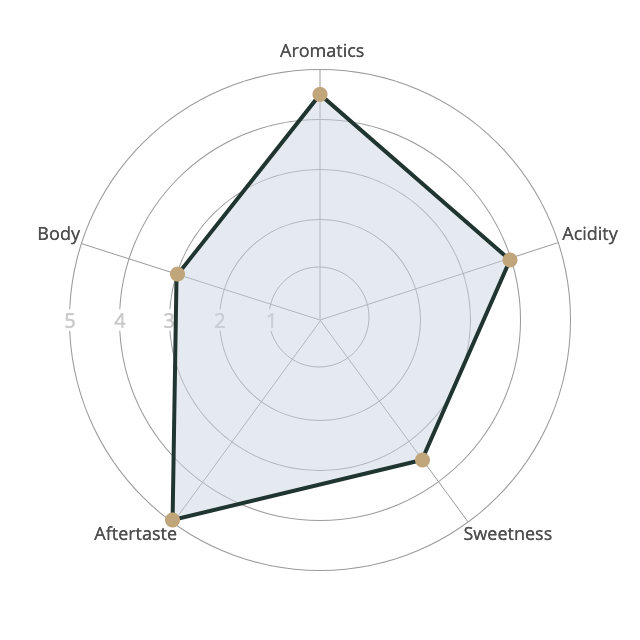Guide to Coffee Tasting Notes
Expert coffee tasters score coffees by “cupping” following the protocols put out by the Specialty Coffee Association (SCA). The standard SCA cupping form is used for recording tasting notes and scoring a common set of attributes used for evaluating the quality of a coffee.

For beginners - and even experienced coffee tasters that haven't been trained on the SCA methodologies - tasting notes can be extremely confusing and intimidating. Acidity? Body? Sweetness? …it all tastes like coffee! Don't sweat it. We're going to explain a little bit about what you should be thinking about when it comes to different coffee tasting notes.
In the Tasting Grounds app, we give you five tasting characteristics to rate on a scale of 1-5 (at 0.5 increments). Why didn't we mirror the SCA cupping form you ask? We hoped to create a good balance of simplicity for those who are less experienced and untrained, yet detailed enough for those who have tasted and scored many coffees.
One important thing to keep in mind when using this scale is that you are NOT scoring “How (enter tasting note here) is this coffee?” - you are scoring the quality of the tasting notes. For example - there might have been a time that you've had a piece of cake that was just too sweet for you. You wouldn't rate that a 5 on sweetness just because it was extremely sweet, you might rate it lower because it was unpleasantly sweet.
If you still find yourself confused about how to identify these qualities in a coffee after reading this, we'd highly suggest you try cupping multiple coffees side-by-side. Comparing unique coffees will really help you pick apart the nuances in coffee characteristics.
Aromatics
Aromatics include the Fragrance and the Aroma of a coffee. Fragrance is the smell of the ground coffee when still dry and Aroma is the smell of the coffee when infused with hot water. You can evaluate the fragrance by sniffing the grounds before pouring water onto the coffee. If you are cupping, there are two distinct phases where you can evaluate aroma. First, by sniffing the aromas released while breaking the crust and second, by sniffing the aromas released while the coffee steeps. If you aren't cupping you might think of the first phase during the bloom and second as the next pour(s) - that all depends on your brew process. The rating you give should reflect the preference of each of the aromatic aspects of your coffee.
Body
Body can be thought of as the “weight” of the coffee. You can perceive it best between your tongue and the roof of your mouth. You might often hear people talk about the “mouthfeel” when referring to the body of a coffee. Terms like watery, creamy, and buttery or light, full, and balanced when describing the body. A light body or a heavy body that is well suited to the coffee can each be considered pleasant and given a high score.
Acidity
Acidity can be the hardest to understand and most contentious tasting note in coffee. The spectrum of acidity is best spanned from “brightness” to “sourness”. There are many types of acids that contribute to flavors in coffee. Some of the most common to think about are:
- Acetic Acid - will remind you of sour, fermenty flavors like vinegar. Typically this will be considered favorable in small amounts, but will be unpleasant when stronger
- Citric Acid - you can probably guess this one! It will remind of you citrus fruit notes and possibly sourness if it is very strong
- Malic Acid - will be quite similar to citric acid, but the most common reminder of malic acid is the crispness, juiciness, and sourness of a green apple
- Phosphoric Acid - will be more closely associated with the sweetness or creaminess of the coffee. You might be reminded of cola or the combination of sweet and tart you get from berries or apples.
This is not a definitive list of acids that you'll find in coffee, but it should give you some things to think about when evaluating acidity. Like with body, a high acidity coffee or a low acidity coffee can each be considered pleasant and given a high score.
Sweetness
Sweetness can obviously refer to sweetness in the terms you are familiar with, but it can also be the result of the perception of a fullness of flavor. Something that may help when it comes to thinking of sweetness is the opposite notes of sour, astringent, vegetal notes. Sweetness comes from sugars, glycols, alcohols, and amino acids in coffee. As a basic rule of thumb, a fruiter sweetness might come through in lighter roasts while caramelier, chocolatier sweetness comes in darker roasts. Each type of sweetness can be enjoyable and the rating should reflect how pleasing it is to you.
Aftertaste
Aftertaste is the length of positive taste and aroma of the coffee that remains on your palate after you've swallowed the coffee. You should think about how the flavors of the coffee linger. Typically, a shorter, unpleasant linger should get a lower score while a longer, positive linger should get a higher score for aftertaste.
